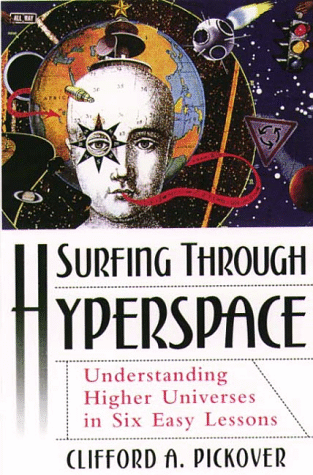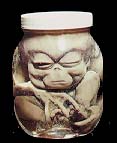Surfing Through Hyperspace
Understanding Higher Universes in Six Easy Lessons

|
A New Book on the Fourth Dimension by Cliff Pickover
|

|
A New Book on the Fourth Dimension by Cliff Pickover
|
"I can't imagine anybody whose mind won't be stretched by this book."
- Arthur C. Clarke
"Pickover just seems to exist in more dimensions than the rest of us."
- Ian Stewart
 "Cliff Pickover's new book is a perfect reflection of
its author's imagination, an imagination so vast it must be hyperspacial
itself! Three dimensions are simply not sufficient to explain Pickover's
astounding breadth of knowledge on such arcane matters as spacetime
wormholes, random walks, and the enormous science fiction literature
dealing with the higher dimensions.
"Cliff Pickover's new book is a perfect reflection of
its author's imagination, an imagination so vast it must be hyperspacial
itself! Three dimensions are simply not sufficient to explain Pickover's
astounding breadth of knowledge on such arcane matters as spacetime
wormholes, random walks, and the enormous science fiction literature
dealing with the higher dimensions.
- Professor Paul J. Nahin, author of Time Machines
"Whimsical, delightful, and always fun, Surfing through Hyperspace will tickle the imagination and boggle the mind. Hyperspace is where physics, mathematics, and science fiction collide. Pickover is our mischievous tour guide for the bizarre realm of higher dimensions, where common sense becomes obsolete. Surfing through Hyperspace teases us to imagine the unimaginable."
- Professor Michio Kaku, author of Hyperspace
"There is no more difficult topic for the human mind to grasp than spatial dimensions beyond three. In this book, Clifford Pickover weaves a science fiction tale with embedded mathematical analysis that explains the fourth dimension in a unique and amusing way. The approach works well in a manner reminiscent of the classic work, Flatland, by Edwin Abbott."
- Charles Ashbacher, Editor, Journal of Recreational
Mathematics
 From the author:
From the author:
I know of no subject in mathematics that has intrigued both children and adults as much as the idea of a fourth dimension -- a spatial direction different from all the directions of our normal three-dimensional space. Philosophers and parapsychologists have meditated upon this dimension that no one can point to but may be all around us. Theologians have speculated that th afterlife, heaven, hell, angels, and our souls could reside in a fourth dimension -- that God and Satan could literally be lumps of hypermatter in a four-dimensional space inches away from our ordinary three-dimensional world. Throughout time, various mystics and prophets have likened our world to a three-dimensional cage and have speculated on how great our perceptions would be if we could break from the confines of our world into higher dimensions. Yet, despite all the philosophical and spiritual implications of the fourth dimension, this extra dimension also has a very practical side. Mathematicians and physicists use the fourth dimension every day in calculations. It's part of important theories that describe the very fabric of our universe.
 Publisher's Weekly Review:
Publisher's Weekly Review:
"Hyperbeings have kidnapped the president! Prolific Discover magazine columnist Pickover (Time: A Traveler's Guide) alternates expositions of math, physics and geometry with episodes of instructional science fiction while showing interested amateurs the mathematical and physical properties of higher spatial dimensions.
Familiar analogies from Edwin Abbott's classic Flatland link up with odder ones from Baha'i and Christian scriptures, The X-Files and the superstring theories of modern cosmologists, as Pickover explains how to trap a 4-D organism or why one twirl through a fourth dimension could turn you into your mirror image. Pickover's usual whimsy is in full force here as he focuses on what four-dimensional organisms could (or do) look like to us: 4-D lifeforms, he explains, could make any 3-D object vanish (or reappear) by lifting it out of (or dropping it back into) our 3-D space. And 4-D creatures with anatomies analogous to ours would probably look, from our limited perspective, like sets of floating, unconnected flesh blobs.
In the book's science-fictional sections, "you" (a Mulderesque
FBI agent) team up with a skeptic named Sally to investigate mysterious
hyperbeings. These second person adventures seemed aimed at young readers,
though they don't get in the way of more sophisticated ideas. Several substantial
appendices describe puzzles and games related to hyperspace, while others
explain related topics (like the mathematical entities called quaternions)
or suggested further reading. Line drawings throughout."
- PUBLISHER'S WEEKLY, AUGUST 1999
Free Times Review:
Pickover's book is one of his many mind-expanding tomes
about science, arguments designed to educate the general reader about such
matters as black holes, the nature of time, and infinity. This time he
explores the fourth dimension and its many versions -- hyperspace, parallel
universes, and wormholes. He's very clever. In this one, he asks us to
image we're someone like Agent Scully at the FBI, asking questions about
whether or not it is possible to walk through walls.
- Teri Tynes, Free Times, Oct 6-12,1999
New Scientist Review:
Playing with the Gods
"Warning: reading this review could leave you memetically modified. For a meme lurks within the pages of Surfing Through Hyperspace, an idea so alluring that it could spread like wildfire, infecting minds everywhere... I fell victim a few minutes after opening the book... Before I knew it I was truly infected.
After explaining how his book would cover all the usual stuff about higher dimensions -- their unimaginability, their weird properties, and how physicists think they may hold the key to understand the Universe -- Pickover sprung his trap: 'I want to know if humankind's gods could exist in the fourth dimension.'
I should have stopped there, but I could not. I read the book in two sittings. I'm still under its influence, which is all the more perplexing considering how abstract and unworldly higher dimensions are. There is the wealth of fascinating ideas and questions he seeks to sow in our minds...
Mark my words: within a few months, you too will come across others in the grip of infection by this amazing book."
-- Robert Matthews, science correspondent The Sunday Telegraph, review in the Oct 23, 1999 New Scientist
 Terms indexed in Surfing Through Hyperspace
(This is meant to give a clearer indication of topics covered.)
Terms indexed in Surfing Through Hyperspace
(This is meant to give a clearer indication of topics covered.)
10-D universe, 15 Abbott, Edwin viii, 23-33, 44, 60, 167 Abdu'l-Baha, xi, An Episode of Flatland, 97 Ana, 99 Appearance (of 4-D beings), xxiv, 50, 69-71, 148, 157, 197 Aquinas, Thomas, 18 Aristotle, 9 Art, 199 Astrians, 98 Atomic stability, 203 Baha'i, vii, xi, 22, 38, 43 Baha'u'llah, vii, 22, 38, 43 Banchoff Klein bottle, 185-188, 225, 227 Banchoff, Thomas, vii, 49, 100, 225, 227 Beaty, William, 208 Bennett, Alan, 138, 225-226 Big Bang, 235 Blood transfusion, 61 Brains, 48-49, 65 Cages, 205-206, 217 Central projection, 100 Challenges of life, 202 Chemistry, 228 Chess games, 75-78 Circulatory system, 197 Closed timelike curves, 223 Communication, 204 Computer programs, 185-197 Cosmological constant, 235 Conference of the Birds, 68 Curved space, 13 Dali, Salvador, 91-93 Dead universes, 203 Degrees of freedom, 2-21 Delta, xvi, 99 Diffusion, 228 Digestion, 197 Digestive systems, 39-41 Distance, 107-108 DNA, 210 Dyson, Freeman, 9-10, 165 Earth, end of, 165-166 Einstein, Albert, 13 Enantiomorphism, 130, 134, 139 Eternitygram, 19 Euclid, 9, 11 Euclidean universe, 224 Evolution, 196-199 Exotic matter, 75 Extrinsic geometry, 12 Eyes, 57-59, 153, 196 Flatland, viii, 23-33, 44-48, 60, 167 Flatland, women, 47-48 Fleas, 205-206 Fractals, 10, 189 Fromm, Eric, 143 Games, 75-78 Gardner, Martin, vii, 49 Gauss, Carl, 13 Ghosts, 130 God, xi, xvi, 9, 18, 21-40, 51, 56, 127, 130, 133, 167, 217 Handedness, 134-135, 139 Hawking, Stephen, 222, 235 Heim, Karl, 10, 47, 130, 185, 192, 196 Heinlein, Robert, xiii, 72 Hendricks, John, 209-210 Hiding, 49 Hinton cubes, 97 Hyperbeings, xiv, 20, 135 Hyperbolic universe, 224 Hypercube, 81-118 rotating, 101 unfolding, 92 Hypersculpture, 51 Hyperseeing, 51 HyperSpace (journal), 191 Hyperspace, origin of term, xvi, 44 Hyperspheres, 81-118 packing of, 115 universe as, 13, 84-86 volume, 109-112 Hypertetrahedral numbers, 174 Hyperthickness, 130 Hypertime, 18 Ice, 205 Inflation theory, 219, 225 Intrinsic geometry, 11 Islam, 217 Kabala, 15-16 Kaku, Michio, 166, 218 Kant, Immanuel, 9, 97 Kata, 99 Klein bottle, 137-138, 185-188, 195, 225 Knots, 123-124 Lattices, 207 Lee, Siu-Leung, vii Leibniz, Gottfried, 133 Light, 199, 229 Linde, Andre, 222 Magic tesseract, 209-210 Many-worlds theory, 72, 223, 235 Mazes, 190 Membrane theory, 220 Miracles, 38, 125 Mirror worlds, 119-132 Miyazaki, Koji, 191 Mobius band model of universe, 135-137, 186 Mobius worlds, 133-135 Monopoly, 78 More, Henry, 130 Morris, Richard, 202 Multiverse, 223, 235 Nonorientable space, 135, 186 Okasaki, Chris, 190 Optical aid, 208 Orbits, 203, Ouspensky, P., 127 Outer Limits, xii Packing, of hyperspheres, 115 Paradoxes, 204 Parallel universes, 71-72, 235 Perpendicular worlds, 62-64 Photons, 199, 229 Plato, 49 Poltergeist, xii Powers (of 4-D beings), xiv, 20, 30, 44 Puzzles, 169 Quantum foam, 65 Quantum theory, 73 Quaternions, 188-191, 227 Raedschelders, Peter, 106-108 Random walk, 169, 226 Religion, xi, xvi, 9, 18, 21-40, 51, 56, 127, 130, 133, 167 Retinas, 57-59, 153, 196 Riemann, Bernhard, 11-12 Rotating in higher dimensions, 120-122 Rubik's Tesseract, 78-79, 170-171, 226 Rucker, Rudy, vii, xiii, 65, 128 Science fiction, 175-178 Senses, 196, 229 Shelley, Percy, 160-161 Slade, Henry, 123, 129 Soul, 20 Sound, 204-205, 229 Speech, 199 Sperm, 36 Spiritualism, 129 Stenger, Victor, 235 String theory, 13-18, 218-220 Superspace, xvii Symmetry, 132, 139 Sz'kwa, 172-173 Tegmark, Max, 202-203 Temperature regulation, 198 Tesseracts, 81-118 magic, 209-210 rose (poem), 155 Thorne, Kip, 74 Time, 18-21, 221 Universe as hypersphere, 13, 84-86, 136, 224, 235 as Mobius band, 135-136 baby, 222, 235 dead, 203 Euclidean, 224, 235 hyperbolic, 224, 236 self-reproducing, 222, 235 size of 136 Upsilon, xvi, 99 Viewer, 208 von Helmhotz, Hermann, 12, 97 Wallis, John, 9 Wheeler, John, xvii Witten, Edward, 15 Wormholes, xvii, 66-67, 74-75, 222, Writing, 199-201 Zanello, Susana, 210 Zollner, Johann, 123, 129
See Pickover books at Amazon.Com